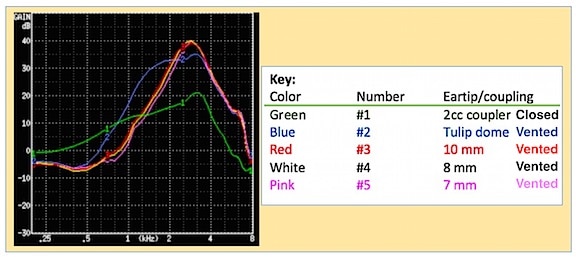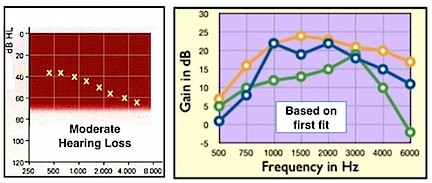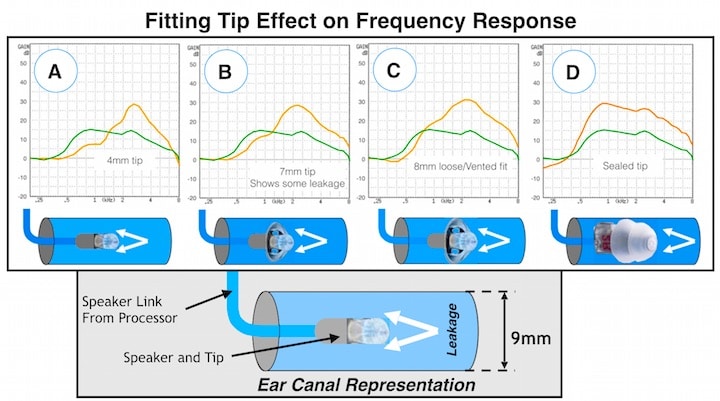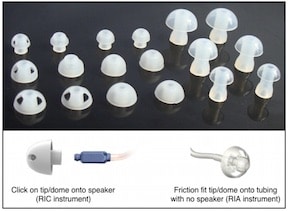Acoustic Over Electronic High-Frequency Response Generation
 The fitting considerations presented here are for RIC hearing aids. The intent is to provide an understanding of what is happening to RIC fittings when the ear tip is modified.
The fitting considerations presented here are for RIC hearing aids. The intent is to provide an understanding of what is happening to RIC fittings when the ear tip is modified.
This post is a continuation from last week.
If you have a RIC fitting that evades user satisfaction, considering something unconventional may be in order, especially if you don’t have a backup option.
Unconventional – Based on an Acoustic Fitting Approach
A measured effect from last week’s post is that an open/vented tip on a RIC hearing aid fitting often provides substantial high-frequency amplification — perhaps too much — especially if “traditional” 2cc frequency response recommendations are used (green line in Figure 1). Although the fitting ideas discussed in this post are cited as unconventional, they may not be as unconventional as one might think, especially when reviewing the recommended 2cc responses for two of the RICs recommended for the moderate loss to which the hearing aids were programmed (Figure 2).

Figure 1. Open coupler measurements versus 2cc coupler measurement (green line) for a recommended fitting of a RIC open/vented tip. All vented responses provided substantial, and mostly steep-rising frequency response.

Figure 2. Moderate sloping hearing loss (left) to which three premium RIC open fit hearing aids were programmed. The frequency responses on the right are the 2cc coupler responses for the quick fit as prescribed by the manufacturers’ fitting software.
Notice especially the frequency responses of Figure 2 for two of the hearing aids (orange and blue lines). Both show greater low-frequency response than does that of the green line. The two low-frequency emphasis responses versus the green line high-frequency response reflects definite fitting philosophy differences. It is easy to see what the consequences of an open fit on the ear would be for the green line response, reflected in Figure 1. But, what about the other two? What is the acoustic impact on their resultant frequency responses? They are more likely to trend in a way that coincides with the remainder of this post, a philosophy this author has advocated for a number of years, starting with work on deep canal hearing aid fittings in the mid 1990s.
Initial Frequency Response
The basic premise is to provide an electronic frequency response that allows for acoustic modification by changing only the tips to generate high-frequency emphasis, rather than by providing this electronically.
- The basic response used as a starting response has little to do with the measured audiometric thresholds, other than to assure that the instrument has sufficient gain.
- The basic frequency response of the hearing aid is important — not because it meets some arbitrarily-chosen fitting formula, but based on what the ear tip coupling will do to the eventual response as delivered to the tympanic membrane (essentially real-ear performance).
- The response selected will have greatest gain in the low-frequencies, similar to that shown in Figure 3, regardless of the audiometric configuration. The actual gain level will depend on, and best determined by the user, and not according to some pre-selected target gain. Allowing the user to select the most appropriate gain should be a first rule of hearing aid fittings. The number of gain level options will depend on circuitry programming.
- Program the gain changes to differ by at least 5 dB.

Figure 3. General recommended 2cc coupler response for an open fit RIC hearing aid to fit the majority of moderate hearing losses, regardless of their audiometric configuration. The user control on the hearing aid is set to allow for gain change and not for response change — the response should remain the same with each gain step, regardless of the number of gain steps available to the user.
The response of Figure 3 was specifically selected because of what it will deliver to the ear when fitted with a RIC open/vented tip. The responses and suggestions are derived from measurements made using the Frye open coupler as described previously:
It should be recognized that a desirable volume level is the most important first step to a successful hearing aid fitting. Additional gain levels can be applied (with the same response), by programming all button pushes to the same response, but with different gains. If these gain increases are not sufficient, then increase the levels further by accessing the “adaptation manager” of the computer software and advancing that to the more experienced listener level, where greater gain occurs (the settings that allow for selection of first-time to experienced listeners), or adjust the overall gain level upward.
Impact of Fitting Tips on the Suggested Frequency Response
It is necessary to understand the general impact on the suggested frequency response when using different fitting tips, and why. Figure 4 shows the changes made to the basic frequency response (green lines) when the ear tip is changed (orange lines). It should be obvious that the greater the amount of venting/leakage around the ear tip, the greater is the high-frequency response. These changes occur acoustically, not electronically.

Figure 4. Acoustic changes resulting from how well RIC fitting tips seal in the ear canal. The greater the leakage/venting, the more the response will be like (A). As the fitting tip reduces the leakage (either around, or through the tip), the response trends to the right. The amount of leakage is not necessarily related to the tip or ear canal size, but to how tightly the tip fits into the ear canal.
The eventual acoustic response is dependent on how tightly the tip, regardless of how it is designed, seals into the ear canal.
If the tip seals, even if it is vented (edges fold over and close the vents), the response of (D) might be expected, providing significantly greater gain, with most being in the low frequencies. A tightly fitting closed tip response would be very similar. This results in an overall gain improvement, both in the low and high frequencies. The greater overall loudness (more response beneath the curve) resulting from such a closed tip fitting, might be reserved for those seeking greater overall gain.
The completely open tip (A) obviously does not seal the ear canal, providing maximum venting capability and showing low-frequency gain reduction and high-frequency gain improvement — the change being made acoustically.
Leakage around and also through the tip is evident in (B). This significant venting results in high-frequency gain improvement with some limited return of low-frequency amplification.
Curve (C) shows that the vented tip provides leakage/venting through the vents designed in the tip, but fits snugly against the ear canal wall. The slightly less leakage from this over (B), results in a slight broadening of the response.
The critical issue is that regardless of the ear canal size, tip size, or the design (open or closed) of the tip, the amount of acoustic change depends on how well the tip seals (intended or not). The more leakage, the more the result will appear as in (A). If sealed, the result will resemble that of (D). Restated, an open/vented tip in an ear may not be perform as an open/vented tip. In some cases, the tip size/configuration/design may actually result in a closed mold fitting when it fits tightly or snugly into the ear canal.







I’ve heard a lot about how it’s important to use hearing aids that are vented. Your information about tip seals showed me that makes a huge difference in getting a better sound than whether or not the hearing aids are vented. I was actually wondering about whether the volume of a hearing aid matters, so it’s helpful to know that I should look for getting a response from beneath the curve of a closed tip fitting ear piece. I’ll be sure to look for that while I’m looking for new hearing aids. Thanks for the information!
https://www.torontohearingservices.com/en/hearing_aids.html
I had no idea that hearing aids had to be fitted to ears. I suppose I just figured that you popped them in. Then again, I know little to nothing about hearing aids. https://www.audiocorp.ca
I had no idea that just by modifying the tip of the hearing aid that it can improved the sound. Hearing aids for some reason are becoming more and more common now days. I know in my family I have two brothers that use them for their whole lives. I have heard about new surgeries that have come out and can potentially cure it permanently. How safe are these new surgical procedures?
https://www.hearingunlimited.ca
My grandfather has to wear hearing aids since he can’t hear well anymore in his old age. My wife and I have been taking care of him, and we needed to learn more about these aids so that we can properly maintain them for him. Thanks for providing this information, and the graphics. The graphic on fitting tip effect on frequency response is exactly what I needed to know to help him with his hearing. https://www.cityhearing.ca